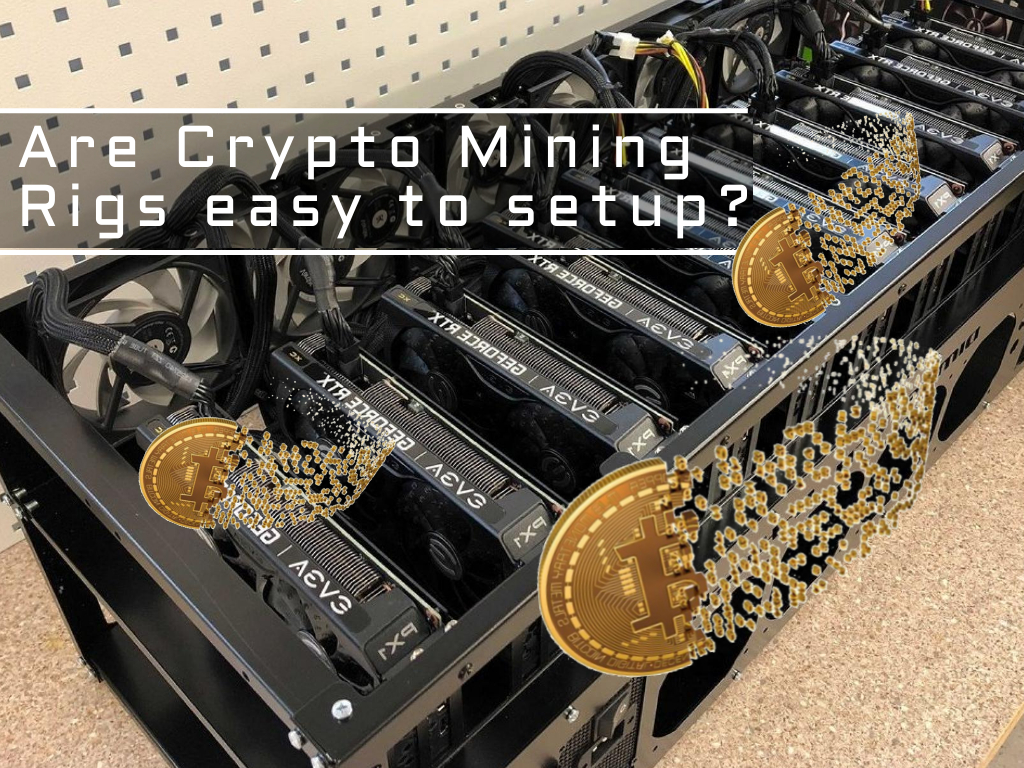Crypto mining, also known as cryptocurrency mining, is the process of using specialized computer hardware to solve complex mathematical equations in order to validate and record transactions on a blockchain network. These transactions are grouped together in blocks, and once a block is verified and added to the blockchain, the miner who solved the equations is rewarded with a certain amount of cryptocurrency.

One way to mine cryptocurrency is by using a mining rig. A mining rig is a dedicated device built specifically for the purpose of mining cryptocurrency. It typically consists of several powerful graphics cards, a power supply, and a motherboard that work together to solve the complex mathematical equations required for mining. These rigs can be set up and operated by individuals or companies, and can be used to mine a variety of different cryptocurrencies.
What is a Crypto Mining Rig?
A mining rig is a specialized computer system that is built specifically for the purpose of mining cryptocurrency. It is a collection of hardware components that work together to solve the complex mathematical equations required to validate and record transactions on a blockchain network.
Key components of a mining rig
The key components of a mining rig include:
- Graphics Cards (GPUs): These are the heart of the mining rig and are responsible for the heavy computational work required to mine cryptocurrency. They are designed to handle complex mathematical equations quickly and efficiently.
- Power Supply: This component provides the necessary electricity to run the mining rig. It needs to be powerful enough to support the high energy consumption of the GPUs.
- Motherboard: This is the central hub of the mining rig and connects all the components together. It ensures that all the components are communicating correctly and that the rig is running smoothly.
- Hard Drive: A hard drive is used to store the operating system and mining software.
- CPU: A CPU is also necessary to run the operating system and the management software of the rig.
- Cooling System: Mining rigs generate a lot of heat, and a proper cooling system is needed to keep the temperature under control and to prevent the components from overheating.
- Frame: A frame is necessary to hold all the components together and to provide the rig with a stable base.
The components of a mining rig can vary depending on the specific needs of the miner, but the graphics cards, power supply, and motherboard are considered to be the most important components for a successful mining operation.
How to set up a mining rig?
Setting up a mining rig can be a complex process, but by following these steps, you can ensure that your rig is set up correctly and is ready to begin mining cryptocurrency.
- Assemble the hardware: Begin by assembling the hardware components of your mining rig, including the graphics cards, power supply, motherboard, hard drive, CPU, and cooling system. Make sure that all the components are securely installed and connected to the appropriate ports.
- Install the operating system: Once the hardware is assembled, you will need to install the operating system on the hard drive. This can be done by creating a bootable USB drive and using it to install the operating system on the hard drive.
- Configure the BIOS: Next, you will need to configure the BIOS settings on the motherboard. This will involve setting the boot order to boot from the USB drive, enabling the integrated graphics, and configuring any other necessary settings.
- Install the mining software: After the operating system is installed, you will need to install the mining software on the rig. This will typically involve downloading the software from the internet and following the installation instructions provided.
- Configure the mining software: Once the mining software is installed, you will need to configure it to match your specific mining rig. This will involve setting the number of graphics cards, the type of cryptocurrency you want to mine, and any other necessary settings.
- Join a mining pool: To increase your chances of successfully mining cryptocurrency, you may want to join a mining pool. A mining pool is a group of miners who work together to mine cryptocurrency and then share the rewards.
- Monitor your rig: Once your mining rig is set up and running, you will need to monitor it to ensure that it is running smoothly. This will involve monitoring the temperature of the graphics cards, the hash rate, and any other relevant metrics.
- Troubleshoot and maintain: As with any electronic device, mining rigs are subject to wear and tear, so it’s important to troubleshoot and maintain the rig to keep it running at its best. This includes monitoring the power supply, the temperature, and the fan speeds.
It’s important to note that setting up a mining rig requires a certain level of technical expertise and that the process may vary depending on the specific components and software used. Additionally, it’s highly recommended to research and consult with experts before proceeding to avoid any potential issues.
Additional software and configurations
In addition to the mining software, there are several other types of software and configurations that may be required for optimal performance of a mining rig.
- Graphics Card Drivers: The graphics cards in a mining rig need to have the latest drivers installed in order to work properly. These drivers can be downloaded from the manufacturer’s website and installed on the mining rig.
- Overclocking software: Overclocking software allows users to push the graphics cards to run at a higher clock speed, which can increase the hashrate and overall performance of the mining rig. However, overclocking can also increase the temperature and power consumption, so it’s important to monitor the rig carefully and adjust the settings as necessary.
- Remote management software: Remote management software allows users to monitor and control the mining rig remotely. This can be useful for monitoring the performance of the rig, troubleshooting issues, and making adjustments to the configuration.
- Power management software: Power management software can help to optimize the power usage of the mining rig. It can help to reduce power consumption when the rig is idle and increase it when it is mining. This can help to save on electricity costs and prolong the life of the components.
- Mining pool software: Joining a mining pool can increase the chances of successfully mining cryptocurrency, and pool software is used to connect the mining rig to the pool and to manage the payouts.
- Monitoring software: To ensure that the rig is running smoothly and to identify any potential issues, it’s important to use monitoring software to track the performance of the rig. This can include monitoring the temperature, the hash rate, and the power consumption of the rig.
It’s important to note that the specific software and configurations required will depend on the components and configuration of the mining rig, as well as the specific cryptocurrency being mined. It’s highly recommended to research and consult with experts before proceeding to ensure that the software and configurations are compatible and will provide optimal performance.

Pros and cons of setting up a mining rig
Setting up a mining rig can be a complex process, but it can also be a valuable investment for those interested in mining cryptocurrency. Here are some of the pros and cons of setting up a mining rig:
Pros:
- Potential for high returns: With the right setup, a mining rig can generate a significant amount of cryptocurrency, which can lead to significant profits.
- Control over the mining process: By setting up your own mining rig, you have full control over the mining process and can make adjustments as needed to optimize performance.
- Flexibility: Mining rigs can be used to mine a variety of different cryptocurrencies, providing you with a range of options.
- Potential for passive income: If the mining rig is set up and configured correctly, it can run on its own and generate a passive income.
Cons:
- High upfront costs: Setting up a mining rig can be expensive, as it requires specialized hardware and software.
- Maintenance costs: Mining rigs require regular maintenance, including monitoring and troubleshooting, which can add to the overall costs.
- Technical expertise required: Setting up a mining rig requires a certain level of technical expertise and knowledge, which can be challenging for those who are less technically inclined.
- The volatility of cryptocurrency prices: The value of cryptocurrency can be highly volatile, which means the returns from mining can be unpredictable.
- High electricity consumption: Mining rigs consume a lot of electricity, which can be costly and also have an environmental impact.
It’s important to note that setting up a mining rig may not be suitable for everyone, and it’s important to carefully consider the pros and cons before proceeding. It’s also highly recommended to research and consult with experts in the field before making any decisions.
Conclusion
In conclusion, setting up a mining rig can be a valuable investment for those interested in mining cryptocurrency. It has the potential for high returns, and provides control over the mining process and flexibility. However, it also comes with high upfront and maintenance costs and requires technical expertise. It’s important to carefully consider the costs, potential returns, and level of technical expertise required before setting up a mining rig. Additionally, it’s highly recommended to research and consult with experts in the field to ensure that the mining rig is set up correctly and is ready to begin mining cryptocurrency. It’s also important to monitor the rig regularly to ensure that it is running smoothly and make adjustments as necessary. Alternative methods of mining cryptocurrency such as cloud mining, mining pools, browser mining, and ASIC mining, also exist and may be worth considering depending on the specific needs and resources of the miner.
Filip Kopa has an MA in Economics and Finances. When bitcoin first appeared, he thought of it as an interesting experiment. His little investments then hit a big turnover, after which he got hooked on cryptocurrencies and a new age of finance.


